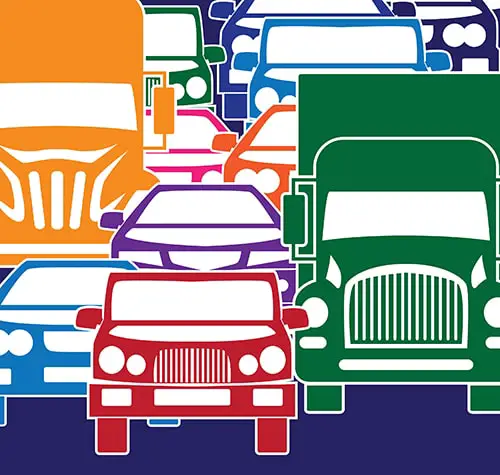Road accidents in the United States
In May 2020, American motor vehicles traveled about 213 billion vehicle-miles on urban and rural roads. Compared with April, traffic increased by almost 45 billion vehicle-miles. Between January and July 2019, traffic volume came to around 3.3 trillion vehicle-miles of travel.
In this statistic, the number of licensed drivers in the United States increasing from 167 million in 1990 to over 227.5 million in 2018.
Road Accidents Facts - 2018
- 227.5 million licensed drivers
- 275.3 million vehicles in operation
- 6.7 million cars involved in traffic crashes
- 2.7 million road traffic-related injuries
- 12,775 occupants of passenger cars were killed
- 36,560 traffic-related fatalities
- 16.07 per 100,000 traffic-related fatalities
- 20,333 cars involved in fatal traffic crashes
- 9,378 crash deaths caused by excessive speed
- 10,511 people died in drunk driving accidents
- 89.6% of people used seat belts
- 71% of motorcyclists were helmeted
- 2.1% of drivers were visibly manipulating hand-held devices while driving

This statistic shows that there were some 279.6 million vehicles operating on roads throughout the United States in the 4th of 2019. The number of vehicles in operation on U.S. roads increased by around 1.6 percent between the fourth quarter of 2018 and the fourth quarter of 2019.
As illustrated by these statistics, about 6.7 million passenger cars were involved in traffic crashes in the United States, which is about 55 percent of the overall total, followed by 38.8% light trucks involved in traffic crashes.
| Vehicles type | Number of vehicles (in thousands) |
|---|---|
| Passenger car | 6,658 |
| Light truck | 4,670 |
| Large truck | 531 |
| Motorcycle | 109 |
| Bus | 65 |
| Other or unknown | 16 |
| Vehicles type | Number of vehicles (in thousands) |
As illustrated by these statistics, more than 6.7 million vehicle crashes occurred in the United States in 2018. About 70 percent, only involved property damage, while 34,000 are fatal.

As illustrated by these statistics, between 2011 and 2017, road traffic injuries in the United States grew by about 530,000 incidents to some 2.7 million road traffic-related injuries in 2017. Over the same period, fatalities had also increased by about 5,000. This follows two decades of a general decrease in the amount of traffic-related injuries.
The accident statistic shows the total number of occupants killed in U.S. road traffic by vehicle type in 2018. In that year, 12,775 occupants of passenger cars were killed in U.S. road traffic, and only 43 occupants of buses were killed during the same period.
Fatal Accidents
Fatal Accidents
This chart illustrates that traffic-related fatalities in the United States were down 1.2 percent between 2018 and 2019. In 2019, the number of traffic-related fatalities in the United States amounted to around 36,120, compared with 36,560 fatalities in 2018.
In 2018, about 228,000 Americans had a license to operate a motor vehicle in the United States. That year, an estimated 36,560 people died on U.S. roads. The ratio of traffic-related fatalities per 100,000 licensed drivers stood at 16.07 in 2018. While there are 22 traffic-related fatalities per 100,000 in the year 2000.
| Vehicle Type | Fatal traffic crashes |
|---|---|
| Passenger car | 20,333 |
| Light truck | 19,775 |
| Motorcycle | 5,115 |
| Large truck | 4,862 |
| Unknown | 988 |
| Other | 565 |
| Bus | 234 |
| Vehicle Type | Fatal traffic crashes |
This statistic is measured by the number of vehicles involved in fatal traffic crashes in the U.S. in 2018. During that year, over 20,000 passenger cars and almost the same number of light trucks were involved in U.S. fatal traffic crashes. The smallest number is 234 for buses involvement in fatal crashes.
This statistic represents the number of speeding-related traffic fatalities in the United States from 2006 to 2018. In 2018, There were 9,378 motor vehicle crash deaths that were caused by driving at an excessive speed representing a six percent decline compared with the previous year, but speeding is more than that. Speeding can also constitute driving too fast for conditions like failing to take traffic or weather conditions into account. With increased speed come increased stopping distances.
Risk factors & mitigation
With all of the public safety and awareness campaigns that we see, it’s hard to believe that drunk driving fatalities increased by 1.7 percent. According to the Centers for Disease Control and Prevention (CDC), 28 people die every day from a drunk driver being behind the wheel. That’s one death every 50 minutes. According to the NHTSA, 10,511 people died in drunk driving accidents in 2018.
In these cases, the highest BAC among drivers involved in the crash was 0.08 grams per deciliter or higher. This figure compares to 36,560 road traffic fatalities in the United States.
| BAC Level | Fatalities |
|---|---|
| BAC 0.00 | 24,075 |
| BAC 0.01 to 0.07 | 1,878 |
| BAC 0.08+ | 10,511 |
| BAC Level | Fatalities |
Looking at the line chart, in 2019, the rate at which people used seat belts was at 90.7 percent, slightly up from 89.6 percent in the previous year. In 2017, 24 states had seat belt use rates of over 90 percent.
Some people just don’t wear seatbelts, regardless of the evidence to the contrary. The 2016 year provided 10,428 reasons to use them. The CDC reports that more than half of all people between 13 and 44 who were occupying a vehicle and died in a crash were unrestrained at the time of impact. Many states require everybody in a passenger vehicle to be seat belted, regardless of where they’re seated. Even with the ready availability of seatbelts and their ability to reduce severe injuries and fatalities, millions of people drive or ride as passengers without seatbelts every day. In the event of a crash, seatbelts are a driver’s or occupant’s first line of defense.

In 2018, the statistics illustrate that just over two percent of drivers were visibly manipulating hand-held devices while driving on U.S. roads. This figure has remained flat over recent years but represents a significant increase over 2005.

As per the National Highway Transportation Safety Administration (NHTSA), there were 37,806 fatalities resulting from motor vehicle crashes in the United States in 2016. That’s a startling 5.6 percent increase from 2015. Four common driver behaviors are reported to have caused about 70 percent of those 2016 fatalities. Those are drunk driving, not wearing a seatbelt, speeding and distracted driving. Peril reigns when a driver participates in all four of those behaviors. According to the NHTSA, here’s how the numbers on those behaviors break down for the 2016 year.
Distracted Driving
The CDC defines distracted driving as participating in an activity that takes a driver’s attention away from the primary task at hand. That task is operating a motor vehicle safely, so as not to injure anybody or damage their property when traveling from a point of origin to a destination. Driving safely requires three different physical and mental functions. Those are:
- Manual in keeping your hands on the steering wheel
- Visual in watching the roadway and traffic around you
- Cognitive in keeping your mind on driving safely
A distraction involving any one of those functions significantly increases the chances of being involved in an accident. Texting while driving is the most dangerous distraction because it involves all three of the required functions. The chances of getting into an accident increase exponentially. The Virginia Tech Traffic Institute reports that sending or receiving a text message takes a driver’s eyes off of the road for about five seconds. At 55 mph, you travel 300 feet. It’s like driving the length of a football field with your eyes closed. There were 3,450 distracted driving deaths in 2016.
These four fatal road accident behaviors can all be avoided with simple awareness and common sense. That operates in the best interests of everybody on the road.
Get more information on DMV Practice Test
